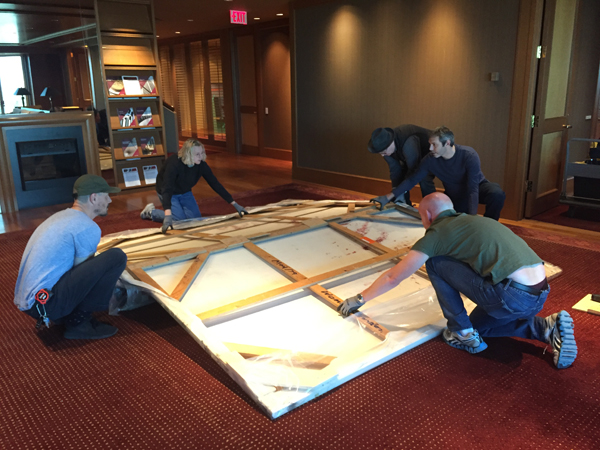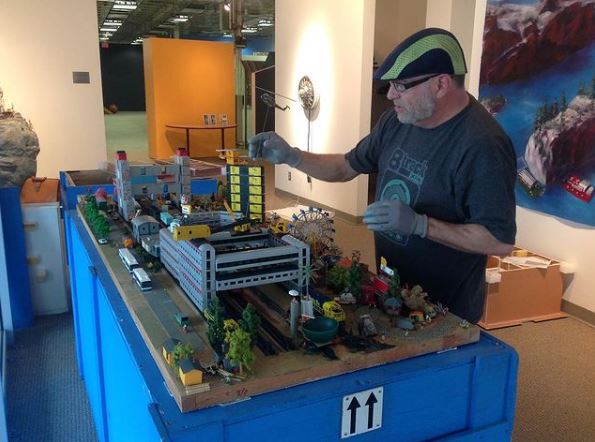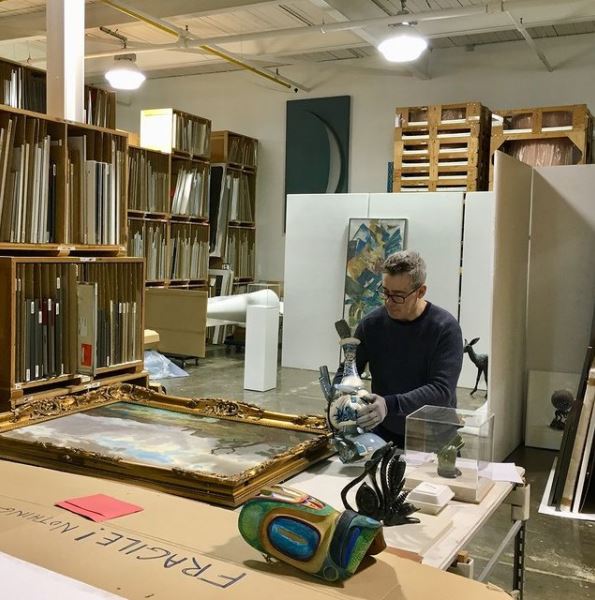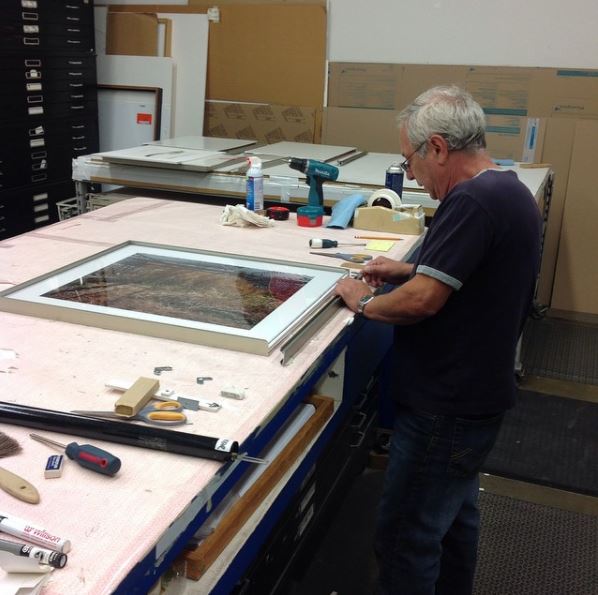Handle with Care: A Chat with the Art Bank’s In-House Technicians and Framer
By: ArtBank / 15 March 2021Today, we’re shining a spotlight on Art Bank staff to celebrate their decades of service and expertise. We interviewed technicians Steven Allen, Dereck Bosley and Luc Raymond and framer Americo Giamberardino to learn more about their history with the Art Bank and the challenges they have faced as part of their work.
Beginnings and introduction to the Art Bank
To get an idea of their backgrounds, we asked Steve, Dereck, Luc and Americo how they had become technicians and when they had first heard about the Art Bank.
Steven told us that his partner had private art gallery, where he worked as an assistant. “I managed everything from installations, framing, packing and handling art for viewings,” he said. “It wasn’t until I began working as a studio assistant for [artist] Jennifer Dickson, RA, helping her with works on paper and photography, that I heard about the Art Bank needing technical services.”
Steven delicately assembling Artists’ Colony (1987–89) by Kim Adams
With a history of helping artist-run centres set up their exhibitions when he was a visual arts student at the University of Ottawa, Dereck eventually crossed paths with the Ottawa Public Art program manager, who enlisted his services as a freelance installer. “Upon working with the City, I formed a loose connection with the Art Bank,” he told us. “That’s how I became familiar with the staff and the work that we do.” And the rest is history!

Dereck leading a team of technicians who are unfolding a large painting
After completing a fine arts degree in Montréal, Luc worked as a stone carver for about five years. Part of his job was to move large, heavy sculptures for people who didn’t know how or didn’t have the means to do it. He recounted, “Eventually, I was hired to deliver and install a sculpture at the Art Bank―that’s where I heard about it for the first time. A couple of years later, I applied for a job here, and I’ve been here for seventeen years.”
Luc preparing a selection of artwork in the Art Bank warehouse
Americo became a framer by circumstance. He bought a self-framing shop from someone that he knew and received most of his training through him. “After a fire unfortunately forced me to close my shop, I set myself up elsewhere,” he revealed. “At this point, the man who sold me the franchise was working at the Art Bank and needed help, so I took on a contract.”
Americo framing a photograph by Edward Burtynsky in the Art Bank frame shop
Wearing many hats
When asked what skill set they believed was ideal within their field, the team unanimously said that a technician or framer should enjoy and be comfortable working with their hands. Possessing strong visual and spatial awareness is also key, as technicians must often move objects into tight spaces or within warehouses that contain many other works of art. They are also called on to draw from skills expected of construction workers, large-scale movers, fine surgeons or craftspeople—all in a single day! And in those cases, being able to work with others efficiently and safely is paramount. No matter what background someone comes in with, their skills will be honed on the job until their every move is instinctual and intuitive.
Challenges and problem-solving
We asked if any installations or framing projects had been particularly challenging, and if any of them had required creativity in finding solutions.
Steven told us about having to install a massive 12 by 15-foot painting in a very tight spot in a hallway. “The whole process was like a complicated choreography and required lots of brain power. And that’s where your trust in the other technicians really comes in.” He added, “you have to be able to count on them, especially when you’re dealing with safety concerns.”
From a framing perspective, Americo mentioned the job he worked for the Juno Awards exhibition, JUNO House: R-Evolutions, in the Canada Council for the Arts’ very own Âjagemô Exhibition Space. “The brief was evolving every day, so there was always more to be done. I ended up asking for all of the selected pieces to be laid out in front of me so that I could look at them and see exactly what frames I needed to order or what backings I needed to change. It was quite an undertaking,” he recalled.
Teamwork makes the dream work
The bond between our art consultants, their assistants, the technicians and the framer has deepened over the many years they’ve installed works of art together. With a shared goal—that of putting smiles on their clients’ faces—the team isn’t afraid to share responsibilities. As they are intimately familiar with the Art Bank’s collection, the technicians can also make suggestions to art consultants and often find themselves curating warehouse racks to facilitate viewings and pre-selections.
The most fulfilling part
While their answers varied when asked what the most fulfilling part of their careers had been, the overarching theme was the sense of reward in having helped a client integrate art into their daily life. Bearing witness to these meaningful connections is what inspires our technicians and framer to continue promoting the services offered by the Art Bank. What’s more, as art lovers and producers in their own right, they are delighted to see the collection evolve through each rental and purchase cycle, cherishing the moments in which they can give emerging artists an extra boost by fastening their name to a plaque.
If you’d like to have Art Bank artwork installed in your workplace, contact us at artbank@canadacouncil.ca. Steven, Dereck, Luc and Americo will be happy to install it!

About the Author: Eleanore Mackie
Eleanore Mackie is a former Young Canada Works intern who worked with the Art Bank team during the summer of 2019 in partnership with the Inuit Art Foundation. A graduate of the master's program in Art History at Queen’s University, she is passionate about creating digital content for arts organizations that is accessible, inclusive, and playful.


